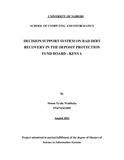| dc.description.abstract | The Deposit Protection Fund Board (DPFB), in particular Institutions in Liquidations division, is
often plagued by a lengthy liquidation process, unpaid loans, collection agency fees and various legal
charges. The unpaid loans and the recovery procedures contribute significantly to the rising cost and
increasing length of the liquidation process. The DPFB does not have any decision support tools that can
be use to guide on debt recovery for institutions in liquidation. They rely on manual methods such us
response to demand notes, the existence of security and the general availability of documents on the loan
to classify whether a loan is a potentially good or bad debt.
Institutions in liquidation have massive loans data, which have been utilised in this project to aid
the learning process of data mining tools in evaluating whether a particular debtor is likely to pay their
debts. These results are meant to act as an enhancement to the mentioned manual methods.
This research explored the effectiveness of various data mining tools in evaluating whether a
debt is likely to be repaid. The research involved recognition of the manual methods DPFB uses in
classifying debts, the IT measures taken by DPFB to enhance debt recovery and the level of success
achieved so far.
Loans data was collected from 27 institutions’ databases. Data was prepared by selecting
suitable variables (predictive and target). The predictive variables were four, namely; amount at
liquidation, contacts availability, debt type and customer type. The target variable was the indication on
whether a debt is good or bad.
Seven data mining methods were selected based on guidance from literature review. Predictive
modelling software – DTREG was employed to train and validate the data mining techniques. The
performance of each of the model was analysed using confusion matrix and area under receiver operating
curve. Results were obtained from both balanced and imbalanced data. Balanced data performed better
than imbalanced. The results which are detailed in chapter four depict that neural networks tools
generally gave high accuracy. These findings guided to the development of a DSS prototype based on
neural networks. This model can be used to aid DPFB decision support on debt recovery.
A neural network based DSS software - Alyuda Forecaster XL whose details a highlighted in
section 4.5 formed the Model Based Management System (MBMS) component of the developed DSS
prototype. On testing the software using different number of debt records, it was noted its classification
accuracy increased with higher number of records.
The Data Base Management System (DBMS) part of the DSS was based on SQL 2000 while the
Dialog Generation and Management System (DGMS) was based on Visual Studio and Crystal Report
software.
In conjunction with the manual methods currently used by DPFB to classify debts, the developed
decision support system is expected to enhance the accuracy of classification that may eventually lead to
curbing the lengthy liquidation period and reduce expenses incurred in the process. | en |


